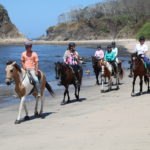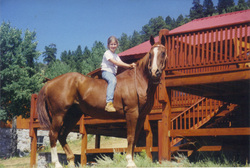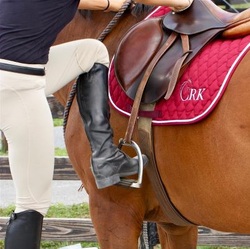What do you do when you come up against a problem in your riding? Do you try harder, do you do more, do you do less, do you back off and look for a different approach?
Many riders have highly “driven” personalities. We want to succeed, to do well, to progress quickly.
However, the drive to succeed can get in our way.
I’ve spent the past three weeks getting a break from the cold Pennsylvania winter and enjoying four of the elements in life I enjoy the most: sun, water, horses, and helping others learn.
We just finished the first destination riding retreat I’ve offered, working with both Wendy Murdoch and Equisol retreats, in Nosara, Costa Rica.

It is always interesting to see the themes that come out of these types of immersive events. These are not planned, but simply rise out of the group dynamic.
This past week, the theme that came up across the unmounted sessions, riding lessons, and even the morning yoga was one of recognizing our own patterns, especially the tendency to always “try harder”, to attempt to push through challenges when that may not be the best solution.
This concept of our human tendency to keep doing something, even when it isn’t working for us, can be explained by basic brain science.
When we do an action, such as sit in the saddle, push our legs forward, and brace against the stirrups, a memory starts to be created in the brain for that movement. As we continue to repeat that pattern of movement or behavior, the memory becomes stronger as a neural pathway is created.
When we run into a challenge, and what we did before no longer works, our brain will stick with what did work in the past.
For example, if pushing into the stirrups provided a sense of security (however false) at the walk, but when we try to pick up trot we feel stiff and out of balance, our brain will go to what worked before – pushing harder in the stirrups.
I refer to this concept in our behavior as “more of the last thing”.
When we feel that something is working we repeat it, and when we hit a challenge or roadblock, we do more of what we think should work, often on a completely unconscious level. This is how our patterns of behavior and movement are created. Many are useful, such as remembering how to drive a car. Some will not be useful, like our earlier example of bracing on the stirrups.
This working harder in a pattern is how a small amount of tightness at the walk turns into feeling completely rigid and unable to go with the movement at all in canter.
As soon as we put our conscious mind to it, purposefully trying harder, we go deeper into that old pattern, and our amount of tension, physical and mental, increases.
The harder we try to get it right, the more we tense up, blocking not only our movement, but also our ability to feel the horse.
Of course, there are situations where the answer is more effort, but what came up for the participants of our retreat and for many of the students I work with on a regular basis is that solving a problem most often requires a new solution, versus simply trying harder.
This requires “stepping back”, softening physically and mentally, before looking for a new way forward.
Consider how you typically handle challenges… is your initial response to back off from a problem or to push yourself harder? If it is pushing harder, what if you had another option and could try something different?
Here are a few questions to get you thinking about other possible solutions:
Think of a current problem you have in your riding… what have you been doing to solve this problem? Is it working? What have you been assuming you need to do to work through this problem? What if that was not true, what else could you try?
See you in the comments!
Callie














19 Responses
Enjoyed this insightful article on neural pathways & our perceptions. Quite a nugget of information to keep in mind,… Thank you
What you’ve talked about makes sense! I’m really struggling with the right lead canter. My horse will toss his head vigorously, bump me out of the saddle, and just stops cantering. This started after my trainer really gathered him up. At one time I was able to canter nicely on the right lead, able to do circles and simple lead changes. I’m very discouraged, my trainer wants to push me through it. She says he knows he can get away with it. I love riding, it’s been my dream since childhood. I started riding at 68 and will turn 72 next month. Do you have a suggestion?
Sincerely,
Karen E Kett-Conner
Karen, is he able to canter on the right lead on the lunge line? Have you ever watched him canter in the field, will he pick up the right lead then? We always like to try to rule out any type of physical limitation before looking at the behavioral aspect!
Julia Burdy, CRK Training Community Manager
Yes, we’ve decided to have a vet check to rule out any physical problems.
The vet gave my horse a flexion test. When the vet held up his hind right he was fine but when the vet held up his hind left my horse was very stiff in the joints. We are going to take him in for X-rays . The vet said she doesn’t think it’s serious, there is no swelling, could have some arthritic changes. He is 14 yrs!
Do you think this is why he has trouble cantering off going clockwise? Especially since his hind left is the first footfall!
Karen, your vet would know much better than I would what his situation is but I would definitely think that is has a huge impact on that lead issue you are having seeing as he must use that leg to push off and initiate the canter! Good for you for looking into this with your vet!
-Julia Burdy, CRK Training Community Manager
Karen,
I want to congratulate you for picking up horsebackriding at 68. I just picked it back up at 57. I am pleased to know that other mature women / man are going back into riding – it is such a lovely sport. 🙂
Dear Callie,
I think the best way to deal with being stuck on a problem is to keep a positive attitude and try to find the reason why You do something in the wrong way. And why You should do it different. First You have to understand and than You need somebody who tells You every single time when You do it so You can recognise it and stop it, otherwise You get used to it over and over.
Have a great day and kind regards,
Sophia
I just got my horse Clancy about 2 weeks ago and his last owners were very strong people personality wise. His teeth are really bad and instead of getting them fixed, they forced the bridle on him. His teeth are fine now, but he still has that fear of the bridle. Any ideas on how to reintroduce it in a good, positive way? Also, he won’t let anyone lift up his hind feet. He doesn’t have shoes back there right now because no one can pick them up. His owner said picking them up caused cramps in his hindquarters. Is that true? Do you have any suggestions?
Great article so true, as a new 63 yr old rider ,watching these young kids hop up and fly around the arena , my fears and truly trying so hard was making my horse ,balk ,just stop ,walk sideways … And not want to go , I have taken a lesson about 3 lessons, 1 every few weeks, and try to practice but couldn’t because the horse I’m leasing would just give me such a hard time, so this past week went back for another lesson and tried a dressage ball spur, and I’m rejuvenated to continue my passion, never give up and get expert help , you’re articles and videos are spot on and love them, thanks Callie!
Good for you, gives me hope at 72, Thanks.
Find someone who tells you every single time you do it ‘RIGHT’ (or do it better), But, I do agree that you need to notice when you do it wrong, just not dwell on it, think of the right way to do it both step by step (left brain) aids then right brain ‘wholistic’ (I’m just reading sally swift/Centered riding!). Change muscle memory as sophie suggests. I’ve also just been watching a video of my first ever TREC ‘competition’ from this morning. And trying to notice when I’m doing it right! So much easier to see our numerous errors. Sally suggests editing these out in your ‘in mind’ video, and riding them as they should have been ridden (in your in mind recreation). SO, current problem: her getting overexcited with increased speed (headshaking, bronc, and yesterday, unseating bucking). Currently solving by. . . . . 1. not going faster! 2. her and my education to aids, along with 3. relaxation for both of us and a secure and relaxed seat for me. Numerous people have said I just need to bite the bullet and let her go. Maybe that is what is needed? (but who looks after her and her companion when I’m in hospital?). Thanks, the discussion is also helpful.
I would love to hear more about your Costa Rica retreat….I was just scheduled to go to the same region and my plans fell through. I would love to do this trip with you next time.
Thanks, Hope
I enjoyed reading this as I can relate! Are you planning another trip back to Costa Rica…I’d be interested in learning more.
I’ve only just had my first lesson, so I shouldn’t really be offering my opinion here, but…
I wonder if you’re familiar with “The Inner Game of Tennis”? It’s about how to stop the conscious mind interfering with our natural ability to learn, and it’s applicable to many activities apart from tennis. It came to my mind while reading this post, anyway.
Callie,
Thank you for writing such an eloquent and helpful article. I do have one of those “push-through” personalities. I was worried last fall (as I am now) when I took an extended break from riding; however, after reading your article, I now see that my concerns then, and now, can be turned from concerns to progress. When I returned last fall after an extended absence from summer riding, I was actually in a better (or different) place with riding. I came back refreshed and what I would call “a more open place of perspective.” I ride because I simply love the experience. Of course I want to know what I’m doing or not doing correctly, but for me I now see in reading your article, I get bogged down or removed from my core pleasure of simply being in the presence of nature and a horse and, simply, building on that. Learning new things as an adult has it’s own set of dynamics – for me, “stepping back” resets my perspective. Your article was so insightful and helpful, I’m going to have Eric (my husband) read it as he has been struggling to reacquaint himself with golf. He played as a teenager and hasn’t since. He’s had 3 lessons (he’s there now) and was ready to sell back his new clubs. I think your article is very timely indeed! Thank you Callie!
Someone once said, “ if the horse is doing something wrong, then you are not doing it right”
My habit that I’m trying to break is nagging with the leg. I ride twice a week in lessons on riding school cobs and have tried the various techniques I have read regarding squeeze, nudge, tap etc. The horses I ride ignore my aids and I slip back into my previous habit, which doesn’t work (I just get a slow plodding pace). I have been focusing on this for a few months now but have got stuck.
Everything I read makes perfect sense but when I try putting it in to practice I fail.
Kat, that is an importance realization you had in noticing that nagging with your leg is causing the school horses to become ‘dull’ to that cue! I know this video is technically on resolutions, however I want you to check out this video Why are Resolutions so Hard? I think it will help you think through the change process. I would also like you to check out this video The Power of Positive Learning.
I hope you find these resources helpful, you are on a great path!
– Julia Burdy, CRK Training Community Manager
Thank you Julia,these are great videos with some really interesting concepts. It has certainly made me start thinking of my challenge from different perspectives and I can’t wait for my next lesson to try some of the ideas 🙂